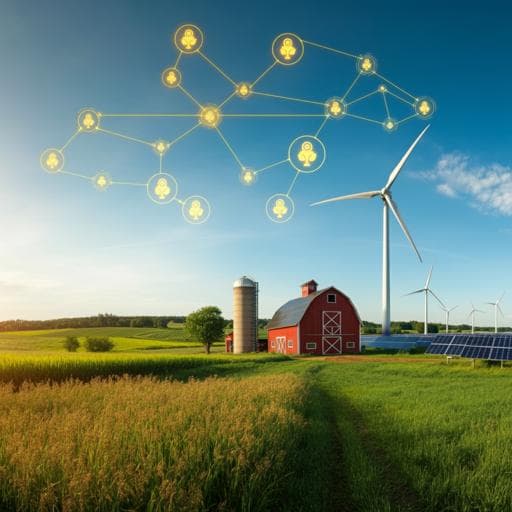
Agriculture
Impact of new media use on farmers' willingness to use clean energy: the role of topography and agricultural income
S. Yin, S. Han, et al.
Discover how new media use, media trust, and ecological cognition play pivotal roles in farmers' willingness to adopt clean energy in Northern China. This groundbreaking research by Shi Yin, Shuai Han, Yijie Liu, and Yilin Wang unveils the complex interactions that could shape sustainable agricultural practices.
~3 min • Beginner • English
Introduction
The study is motivated by rising global carbon emissions and China’s dual carbon targets (peak by 2030, neutrality by 2060). Rural China still relies heavily on traditional energy (e.g., coal, biomass), creating environmental and carbon challenges. Clean energy promotion in rural areas requires widespread household adoption, which hinges on farmers’ cognition and willingness. The paper posits that ecological cognition (EC) is foundational to farmers’ decision processes about adopting clean energy, and that new media use (NMU) has become a critical information channel shaping EC and, in turn, willingness to use clean energy (WTUCE). Media trust (MT) may shape how effectively NMU translates into EC due to misinformation and credibility concerns. The research aims to model the micro-level mechanisms linking NMU, MT, and EC to WTUCE; to test whether EC mediates the NMU–WTUCE link and whether MT moderates the NMU–EC link; and to examine heterogeneity across terrain (plains vs. mountainous) and income structure (nonagricultural income share).
Literature Review
The paper reviews prior work on factors influencing farmers’ WTUCE, including income, policy support and subsidies, infrastructure, education, village topography, and cognition. The literature indicates higher income and education, stronger policy support, and better infrastructure correlate with higher WTUCE. The review then synthesizes four focal constructs: (1) WTUCE: willingness to use solar, wind, heat energy, clean straw utilization, and new energy vehicles; influenced by policy, income, education, and village attractiveness. (2) New Media Use (NMU): new media defined as interactive, digital, networked platforms (e.g., Douyin/TikTok, Kuaishou, WeChat, Weibo, Bilibili). NMU is driven by social, cognitive, entertainment, and self-presentation needs; it can influence perceptions and potentially WTUCE through information exposure, interaction, spillovers, and learning effects. (3) Media Trust (MT): trust in media has shifted from traditional to new media for some audiences; MT comprises information credibility, source credibility, and media-type credibility. Higher media proficiency links to higher trust and continued use. MT may condition how NMU affects cognition. (4) Ecological Cognition (EC): farmers’ understanding of environmental status, pollution, protection measures, and the agriculture–ecology interdependence; EC supports green production behaviors and can mediate policy effects. Based on the theory of planned behavior and information/learning effects from new media, the study proposes hypotheses: H1: NMU positively affects WTUCE; H2: EC positively affects WTUCE; H3: NMU positively affects EC; H4: MT moderates the NMU–EC relationship; H5: EC mediates the NMU–WTUCE relationship. The study also anticipates heterogeneity by terrain and nonagricultural income ratio.
Methodology
Design: Cross-sectional questionnaire measuring four latent constructs—NMU, MT, EC, and WTUCE—with 20 items on five-point Likert scales, adapted from established instruments to the rural clean energy context. The questionnaire comprised: (1) demographics (gender, age, education, income, nonagricultural income share, Party/village cadre status, local topography, prior clean energy use); (2) NMU and MT (usage time/years; trust in information, source, and media type); (3) EC (five items on ecological/environmental understanding); (4) WTUCE (support for various clean energy types). Study Area and Sampling: Rural respondents primarily in Hebei, Shandong, Henan, and Shanxi (northern China), where rural infrastructure and economic development are relatively less advanced. Data Collection: Online distribution via Juanxing platform using interpersonal networks on WeChat and QQ, plus some field visits. Survey period: Jan 30–Mar 1, 2024. Sample: 300 collected; 263 valid (87.7% valid rate). Analysis Tools: SPSS 26.0 and structural equation modeling (SEM). Reliability and Validity: Cronbach’s alpha: NMU 0.873, MT 0.885, EC 0.885, WTUCE 0.885 (>0.7 acceptable). EFA: KMO 0.929; Bartlett’s test p<0.001; four factors extracted (NMU, MT, EC, WTUCE); cumulative variance explained 69.655%. CFA/Convergent validity: standardized loadings >0.5; AVE>0.50; CR>0.70 across constructs; good discriminant validity (square roots of AVEs > inter-construct correlations). SEM Model Fit: CMIN/DF=2.899, RMSEA=0.085, GFI=0.877, AGFI=0.841, CFI=0.928, IFI=0.929, TLI=0.919, indicating acceptable-to-good fit. Hypothesis Testing: Path analysis for H1–H3; mediation (H5) tested via bootstrapping (5000 resamples; 95% bias-corrected CI); moderation (H4) tested via interaction term (NMU×MT) with simple slope analysis. Heterogeneity Analyses: Multi-group style analyses by topography (plains vs. mountainous) and by nonagricultural income share (low <60% vs. high ≥60%).
Key Findings
- Descriptive: 263 valid responses; 56.7% female; main age groups 18–30 (34.2%) and 41–50 (38.8%); education college or above 42.6%; 72.6% live in plains; 69.2% reported having used clean energy. - Reliability/Validity: Cronbach’s alpha ≥0.873; KMO=0.929; AVE>0.5 and CR>0.7; discriminant validity satisfied. - SEM Paths: NMU → WTUCE positive and significant (β=0.171, SE=0.070, CR=2.440, p<0.05) supporting H1. EC → WTUCE positive and highly significant (β=0.729, SE=0.073, CR=10.060, p<0.001) supporting H2. NMU → EC positive and highly significant (β=0.738, SE=0.056, CR=13.176, p<0.001) supporting H3. - Mediation (H5): EC exerts a significant mediating effect in the NMU → WTUCE relationship. Bootstrap mediation effect ≈0.543 (95% CI [0.331, 0.850], significant), indicating complete mediation in the authors’ tests (direct effect becomes nonsignificant when EC is included). - Moderation (H4): MT moderates NMU → EC. Interaction term effect is negative and significant (estimate ≈ −0.0615, p<0.05; 95% CI [−0.1210, −0.0019]), implying that higher MT weakens the positive effect of NMU on EC. Simple slopes: low MT 0.367***; average MT 0.305***; high MT 0.244**. - Heterogeneity by Topography: In plains areas, NMU directly strengthens EC more strongly; the direct NMU→EC effect is 21.43% larger than in mountainous areas; MT does not significantly moderate NMU→EC in plains. In mountainous areas, MT significantly moderates NMU→EC (moderation present), amplifying the role of NMU in shaping EC when MT is higher. - Heterogeneity by Nonagricultural Income Share: For low nonagricultural income households, MT moderates NMU→EC (moderation present). For high nonagricultural income households, the direct NMU→EC effect is stronger by 14.30%, and MT’s moderating effect is not significant.
Discussion
The findings support the theoretical model that NMU enhances EC, which in turn promotes WTUCE, consistent with the theory of planned behavior and information-learning mechanisms of new media. EC acts as the proximal driver of WTUCE, fully mediating the influence of NMU on willingness: new media primarily works by raising ecological understanding rather than directly shifting willingness when cognition is controlled. MT conditions how effectively NMU translates into EC: lower MT settings show steeper NMU→EC slopes, while higher MT settings attenuate the slope, indicating that trust calibrates how users process and internalize information encountered via new media. Terrain and income-structure heterogeneity underline contextual factors: in plains, better infrastructure, information access, and openness strengthen the direct NMU→EC linkage, reducing reliance on MT’s moderating role. In mountainous regions, credibility considerations are more salient, so MT’s interaction with NMU is needed to bolster EC. Similarly, households with high nonagricultural income likely have greater exposure to urban information and technologies, strengthening direct NMU→EC effects and diminishing moderation by MT; low nonagricultural income households depend more on media credibility for NMU to translate into EC. These results highlight that communication infrastructure, socio-economic exposure, and trust ecosystems shape how media influences ecological cognition and clean energy willingness.
Conclusion
This study builds and validates a micro-level SEM linking NMU, MT, EC, and WTUCE among rural households in northern China. NMU positively influences WTUCE, EC strongly promotes WTUCE, and NMU raises EC. EC mediates the NMU–WTUCE relationship (complete mediation in this sample), while MT moderates NMU’s effect on EC, generally attenuating the slope at higher trust levels. Heterogeneity analyses show MT’s moderating role is present in mountainous regions and among households with lower nonagricultural income, whereas direct NMU→EC effects are stronger in plains and among higher nonagricultural income households. Contributions include clarifying internal mechanisms (NMU→EC→WTUCE), identifying MT’s moderating role, and offering terrain- and income-tailored insights. Future research should expand mechanisms to include policy implementation, energy cognition granularity, economic factors, and multi-actor interactions, and broaden heterogeneity analyses to political outlook, gender, age, and education to refine clean energy promotion strategies.
Limitations
- Scope of heterogeneity: Only terrain (plains vs. mountainous) and nonagricultural income share were examined; other socio-demographic and institutional heterogeneities (e.g., political outlook, gender, age, education) were not tested. - External validity: Sample concentrated in four northern provinces; findings may not generalize to all rural contexts in China. - Cross-sectional design: Limits causal inference; longitudinal or experimental designs could strengthen mediation/moderation claims. - Measurement constraints: Self-reported NMU, MT, EC, and WTUCE may be subject to response biases. - Data access: Data are proprietary to Hebei Agricultural University; limited public availability may constrain replication.
Related Publications
Explore these studies to deepen your understanding of the subject.







